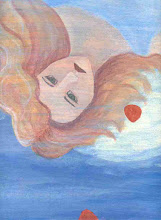Welcome
to My Broken-down Garden
Welcome to my broken-down garden. An herb garden is marked by a bent piece of
rebar that was cast away. A folding
table that no longer unfolds provides a step between the baby spinach and the
young Romaine lettuce. Tomato plants
find support in wooden chairs with no seats.
The slats from the chair-seats tangle with fallen-down tree branches to
form the outer perimeter of a kitchen garden.
In the center of the kitchen
garden, the glass globe from a birdfeeder and a metal mushroom are transformed into
a gazing ball. A bird trapped itself
inside the birdfeeder two days after I had hung it one winter. I rescued the bird -- safe but scared -- and
took down the feeder. Now the copper top
and bottom form shelves to a better-designed feeder that hangs from a branch of
a distant tree.
Rosemary grows tall and mint grows
wild around bits of shattered birdhouses in the broken-down garden. The footrest from an Adirondack chair
provides a bridge of shade for tender strawberry plants. Mismatched planters
contain the beginnings of parsley, coriander, basil and sage.
On the outer edge of the of the
kitchen garden, marigold and coreopsis reflect the sun’s light and sweeten the
air, while Mexican heather and Gerbera daisies try, without success, to tone
down the more garish hues. A rusty
sundial settles into a secure corner, away from the blades of the lawnmower and
the distracting shadows of tall trees. A
glass balloon rises from a rod and chimes with every breeze or gust of wind,
its blue iridescent glass doubling the
function of the gazing ball.
There is always part of the garden
where nothing grows. Even the weeds will
visit, but soon pack up their roots and move on to more welcoming soils. And here, in this space of nothingness, is
where I inevitably want to plant. I
cannot accept that the land in front of the riotous azaleas and before the
forlorn stone bench should remain empty, barren.
And so, this year, I cut off and
uproot a section of the potted lavender that has flourished despite, and not
because of, my ministrations. I take the
scrawny sprig and two discounted bulbs, a bag of potting soil and an old
trowel, and try to break the curse of the fallow land.
The lavender I plant first, halfway
between the curved stone bench and the peacock, because I somehow know that
peacocks, even brightly painted metal ones, love lavender. I dig holes, one on either side of the
lavender, and settle the bulbs into their new and, I hope, not inhospitable
homes.
For a moment, I admire the green
life seemingly sprouting from where death once multiplied. Then I turn the metal peacock to face the
lavender as if to say, “See? I know how you have suffered.” Even then, I know I may be planting more
disappointment. But I also know, perhaps
more than most, that sometimes something wonderful can grow from brokenness,
and emptiness and barrenness. And there
is always room for hope in my broken-down garden


No comments:
Post a Comment